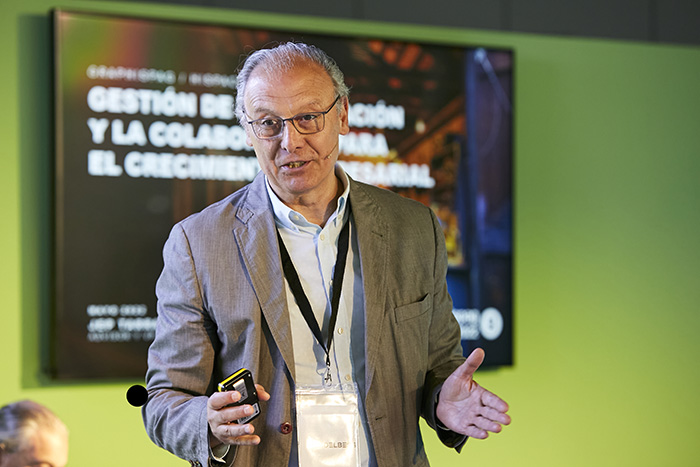Jep Tarrades, VP Tecnologia – Loop New Business Models
In today’s changing environment, companies need to adapt and understand what their customers demand in order to meet the market’s requirements and anticipate them whenever possible. Jep Tarrades is an industrial engineer who has held different positions of responsibility at HP. He now puts his experience and knowledge at the service of innovation, a tool that’s essential in enabling companies to remain competitive, as he explained during his talk at Graphispag.
We begin with the idea that innovation and collaboration are basic and interrelated factors. This is because no company has the capacity and knowledge required to make all the changes on its own, without the cooperation of other partners.
Innovation, much more than the R&D area
Innovation covers all the areas of a company and is of a cross-cutting nature. But it must also be borne in mind that making it possible requires the support, leadership and dedication of the management team.
Innovation in each organisation is different, diverse and complex and, therefore, innovation has to be tailored to each company. Drawing a parallel with a recipe, if innovation were a cake, the ingredients would be as follows:
- People: the company must create the optimal conditions to attract and retain talent, promote diversity and offer a career development plan to increase the teams’ loyalty.
- Added value in the products and/or services: it’s vital to understand what makes our products/services distinctive and remain attentive to changes, innovations and market demands.
- Customer insight: this doesn’t just involve listening to what the customers expressly say, but also ascertaining through observation how we can improve their service/products/business (what we call “unspoken user needs”).
- Flexibility in adapting to changes: we’ve moved on to a hybrid work setting with an increase in e-commerce and the emergence of the digital environment (just as we moved on from film photography to digital cameras), as well as changes in business models, with a shift from transactional sales to usage-based models.
In doing so, our business innovation takes place at the confluence of three areas: technology, market and society. I have an impact when I have distinctive technology which the market appreciates and is willing to invest in and it has an impact on society in matters related, for example, to sustainability and logistics.
What differentiates innovative companies from ones that aren’t? The people that form part of the teams and their commitment.

The culture of innovation, a crucial reference
Everything begins with the culture of innovation. There are lots of ideas, but some get lost, so an environment must be created to review them and analyse whether they should move forward or stay where they are. You have to go out and look beyond the company to confirm that the idea is valuable and that someone is willing to pay for it. And, if you get results at a certain speed, the innovation will attract more and more customers.
Shared knowledge can help us to achieve results. One example of how we can do so consists of three phases:
- Phase 1: awareness-raising workshops for the teams. These sessions involve work with the team to provide them with tools and encourage corporate entrepreneurship.
- Phase 2: identification of opportunities within the company with a view to developing potential new products/services and/or business models.
- Phase 3: definition of new products and business models, starting with the prioritised areas of opportunity, giving them a practical focus and prioritising new products.
How can I create the culture and processes to innovate?
We all have the tools. It’s a matter of applying three concepts:
- Sharing: from the company management to all levels, open to all.
- Working together: the idea may come from a particular person or a small group, but it’s best when the rest of the group contributes to making the idea bigger.
- Connecting with all the key internal and external players. Trade fairs are an example of the above, as they create communities of practice.
There’s no other choice. It will occur in one area or another or to a greater or lesser extent, but we’re all driven to innovate, and we should bear in mind that it’s very difficult for innovation to take place in an organisation that’s created solely to optimise and produce.
Reflections on innovation
- Have we rethought all the conventions and dogmas of faith that we have?
- Do I focus only on the commercial and sales side of things or do I really do so on the customer and my customers’ customers? They’re the ones who buy from me and appreciate it.
- Are we a flexible and adaptable organisation in which everyone can contribute, or are we a vertical organisation in which ideas only come from a specific part?
- Do we take all the players in our ecosystem, suppliers, customers and competitors, into account? Competition is very healthy and can be very productive.
- Have we reinvented our value proposition? What can I do to further improve my bottom line and generate more profitability? You’re in a virtuous circle, you generate more profitability and, therefore, you can invest more in R&D and other services and fulfil your customers’ expectations.
Cristina Benavides, Graphispag contributor




